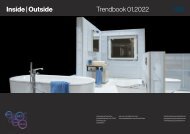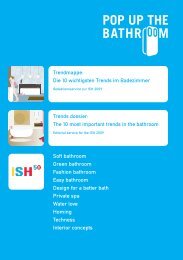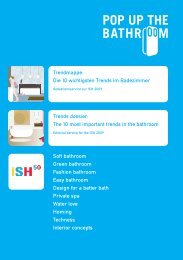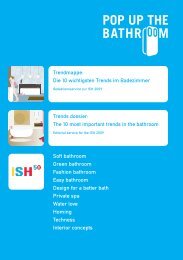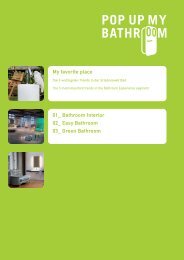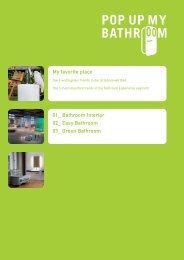My favorite place - Trendbook Pop up my Bathroom | Issue 01/2011 ISH 2011
Today’s bathrooms are no longer chilly, wipe-clean functional cells. Bathrooms are turning into living space. As simple as this meanwhile ubiquitously manifest megatrend might sound, its impact on the sanitary industry and the conceptual possibilities for bathroom design are nothing short of revolutionary. As a result, expectations of the aesthetics and functionality of contemporary bathroom design are growing. Accordingly, there will be more than “just” new products on show at the world’s leading fair for the sanitary industry, the ISH in Frankfurt. For it is not the bathtub that is being reinvented, but the entire bathroom.
Today’s bathrooms are no longer chilly, wipe-clean functional cells. Bathrooms are turning into living space. As simple as this meanwhile ubiquitously manifest megatrend might sound, its impact on the sanitary industry and the conceptual possibilities for bathroom design are nothing short of revolutionary. As a result, expectations of the aesthetics and functionality of contemporary bathroom design are growing. Accordingly, there will be more than “just” new products on show at the world’s leading fair for the sanitary industry, the ISH in Frankfurt. For it is not the bathtub that is being reinvented, but the entire bathroom.
You also want an ePaper? Increase the reach of your titles
YUMPU automatically turns print PDFs into web optimized ePapers that Google loves.
dukte selbst. Am deutlichsten ist dieser evolutionäre<br />
Sprung an der Badewanne abzulesen,<br />
die sich von einer rein „negativen“ Form, also<br />
einem Hohlkörper, die einer (meist verfliesten)<br />
Umrandung und des Anschlusses an der Zimmerwand<br />
bedurfte, zu einem selbständigen,<br />
skulpturalen Objekt entwickelte, das frei im Raum<br />
platziert werden kann. Die Dusche wurde dafür<br />
soweit reduziert, dass sie als bodengleich integrierter<br />
Raum im Raum realisiert werden kann<br />
und zu einem rein architektonischen Element wird.<br />
Wanne und wohnliche Materialien machen<br />
das Bad zum Zimmer<br />
Mit der Badewanne fing alles an. Seit das Bild<br />
von Philippe Starcks erster Badkollektion um<br />
die Welt ging, fing man an, Sanitärobjekte als<br />
Möbel aufzufassen, die einen Raum für sich benötigen.<br />
Heute ist die frei stehende Badewanne<br />
das Zentrum vieler Raumkonzepte, die das Bad<br />
als vollwertigen Raum mit unterschiedlichen<br />
Nutzungszonen auffassen. Dabei lösen sich die<br />
Sanitärobjekte mehr und mehr von der Wand,<br />
ragen in den Raum hinein oder werden mittig<br />
platziert. Dadurch entstehen Sichtachsen, sich<br />
durchdringende oder abgeschirmte Raumteile.<br />
Aus Duschen werden Raumteiler, Vorwandelemente<br />
nehmen Armaturen und Waschbecken<br />
auf, und das WC verschwindet, wenn schon<br />
nicht ganz aus dem Bad, so doch zumindest in<br />
eine abtrennbare Nische. Denn der Rest des<br />
Bades wird als Wohnfläche definiert, die etwa<br />
durch Relax-Möbel und Teppiche ausgestattet<br />
wird. Dabei ist der Umfang, die Struktur und<br />
die „Bespielung“ mit Sanitärausstattungen dem<br />
jeweiligen Bedarf entsprechend zu wählen.<br />
Standardrepertoires sind kein Pflichtprogramm<br />
mehr. Raumkonzepte – insbesondere, wenn sie<br />
von einem Badplaner auf eine Person, eine<br />
Familie oder eine Institution zugeschnitten<br />
werden – schaffen den lange vermissten<br />
Spielraum zur Individualisierung des Bades.<br />
Gestalterisch gibt es dabei zwei Richtungen:<br />
Entweder werden Waschtisch, Badewanne und<br />
Dusche zu einem architektonischen Element<br />
reduziert, mit dem sich Räume „bauen“ lassen,<br />
oder sie werden zu Objekten, die selbst einen<br />
Raum einnehmen – einen Hof, um den herum<br />
sich der Nutzer bewegt. Zuletzt trieb Kaldewei<br />
das Prinzip „Weg von der Wand“ mit dem Duschteller<br />
Piatto auf eine atemberaubende Spitze:<br />
Mit ihrem bühnenreifen Vorhang beansprucht<br />
das Ensemble aus Duschteller, magnetisch<br />
fixiertem Spritzschutz und Armaturenstele<br />
(Dornbracht) einen publikumswirksamen Platz,<br />
der die Grenze zwischen Wohnraum und Bad<br />
völlig aufhebt.<br />
Damit beweist das Baddesign aber nicht etwa<br />
seine Sonderstellung, sondern vollzieht vielmehr<br />
nach, was sich im Interior Design und<br />
im Produktdesign der anderen Wohnbereiche<br />
abspielt. Denn auch hier wird der Raum offener<br />
aufgefasst. Dadurch kommt auch in kleinere<br />
Grundrisse mehr Großzügigkeit, und die Zusammenlegung<br />
der Wohnbereiche, in denen das<br />
private wie das gesellige Leben stattfindet –<br />
Wohnen, Arbeiten, Essen und Kochen – findet<br />
seinen Niederschlag in einem offenen Küchen-<br />
Layout, in dem immer häufiger eine zentrale Kücheninsel,<br />
kombiniert mit einem Essplatz, den<br />
Mittelpunkt bildet. Wände werden auf- oder abgebrochen<br />
und durch Kücheninseln, Raumtrenner,<br />
Sofasysteme, Schränke und Regale ersetzt.<br />
Möbel übernehmen immer mehr die Aufgabe,<br />
Zonen und Funktionen zu differenzieren. Das<br />
ist im Bad nicht anders. Daher wird modernes<br />
Baddesign Produkte bevorzugen, die diese<br />
architektonische Qualität besitzen; mit ihnen<br />
lässt sich eine eigene Atmosphäre generieren,<br />
Intimbereiche lassen sich abtrennen. Selbst<br />
Heizkörper werden, wie bei dem Modell Fedon<br />
(Kermi), zu Wohnobjekten, die sich farblich<br />
anz<strong>up</strong>assen verstehen und sogar zum Beleuchtungselement<br />
werden. Neben umfangreichen<br />
und modular aufgebauten Programmen, die<br />
13<br />
The tub and snug materials are turning the<br />
bathroom into living space<br />
It all started with the bathtub. When pictures<br />
of Philippe Starck’s first bathroom collection<br />
began going round the world, people started<br />
regarding sanitaryware as furniture that<br />
requires a room for itself. Today the freestanding<br />
bathtub is at the centre of many layout<br />
concepts that interpret the bathroom as a fullyfledged<br />
room with different usage zones. At the<br />
same time, the sanitaryware is increasingly<br />
liberating itself from the wall, projecting into<br />
the space or being positioned centrally. This<br />
creates sightlines, interlinked areas and secluded<br />
zones. Showers are turning into room dividers,<br />
wall sections accommodate the fittings and<br />
wash basin and the toilet is doing a disappearing<br />
act, either vanishing from the bathroom<br />
entirely or at least retreating into a separable<br />
alcove. For the rest of the bathroom is now defined<br />
as living space and being furnished with<br />
relaxing furniture and cosy carpets. The extent,<br />
structure and “layouting” of the sanitaryware<br />
can be chosen according to individual needs.<br />
Standard repertoires are no longer compulsory.<br />
Layout concepts - especially if a bathroom<br />
planner tailors them to a specific person, family<br />
or institution – are rectifying the previous<br />
lack of scope for individualising the bathroom.<br />
When it comes to design there are two directions:<br />
Either the washstand, bathtub and shower are<br />
reduced to an architectural element that can be<br />
used to “build” spaces, or they become objects<br />
that themselves occ<strong>up</strong>y a space – a courtyard<br />
around which the user moves. Kaldewei recently<br />
took the “away from the wall” principle to<br />
breathtaking extremes with its Piatto shower<br />
plate: With its theatrical curtain, the ensemble<br />
consisting of shower tray, magnetically attached<br />
splash guard and fitting stele (Dornbracht) lays<br />
claim to a show-stealing position that totally<br />
abolishes the boundary between the living<br />
space and bathroom.<br />
But bathroom design is not so much being<br />
afforded special status as re-enacting what is<br />
already happening to the interior design and<br />
product design in other areas of the home.<br />
For here too, the space is being interpreted<br />
more openly. This brings a sense of largesse<br />
even to smaller floor plans and the merger<br />
of the living areas in which both private<br />
and social life takes <strong>place</strong> – living, working,<br />
eating and cooking – is being echoed in an<br />
open-plan kitchen layout in which a central<br />
cooking island, combined with a dining<br />
area, is increasingly taking centre stage.<br />
Walls are being opened <strong>up</strong> or torn down and<br />
re<strong>place</strong>d with island arrangements, room<br />
dividers, sofa systems, c<strong>up</strong>boards and shelving.<br />
Furniture is increasingly being assigned the role<br />
of differentiating between zones and functions.<br />
It’s no different in the bathroom. That is why<br />
modern bathroom design will favour products<br />
with precisely this architectural quality; they<br />
allow the planner to generate an individual<br />
atmosphere and partition intimate areas off.<br />
Even radiators like Kermi’s Fedon model are<br />
turning into interior design items that can<br />
adapt to the colour scheme and even double<br />
as a lighting element. In addition to extensive<br />
and modularly structured product ranges<br />
which – by virtue of their vast array of cabinet<br />
elements, finishes, measurements and fitting<br />
variants that include freestanding, wall, ceiling<br />
or deck-mounted models – can be combined<br />
to create space-structuring arrangements,<br />
there are also some striking product concepts<br />
that venture to step away from the wall all by<br />
themselves and create their own space, such<br />
as the Edition Atelier mirror cabinet wall by<br />
Keuco. Duravit’s Mirrorwall is an eye-catcher<br />
in its own right and also forms its own space,<br />
seemingly created by opening the doors<br />
in front of and behind the washbasin –



